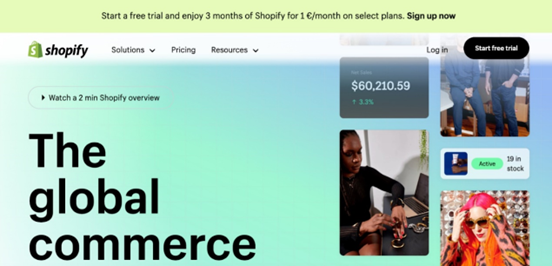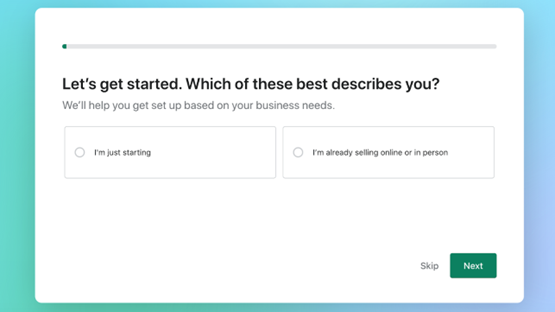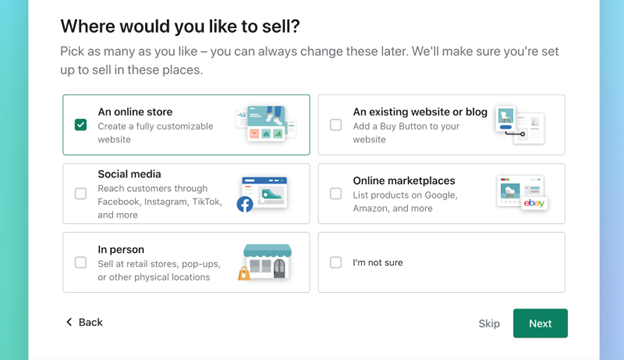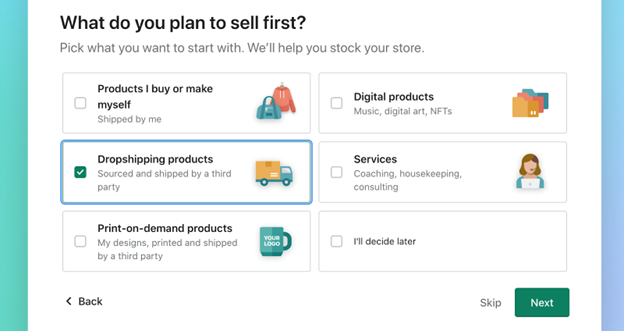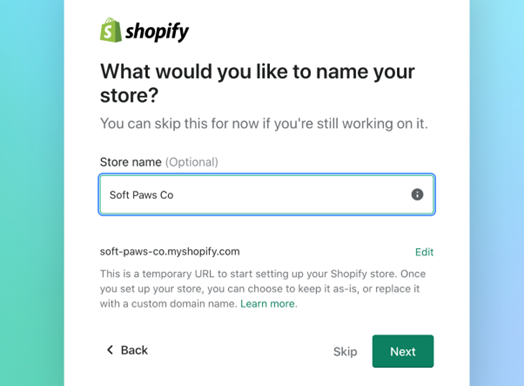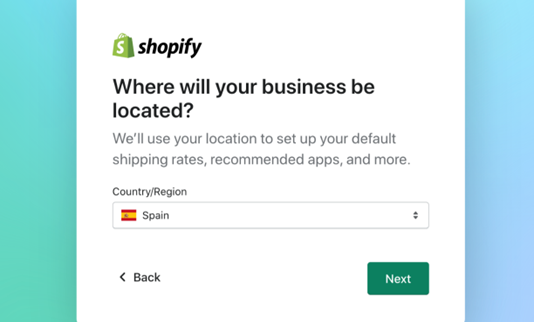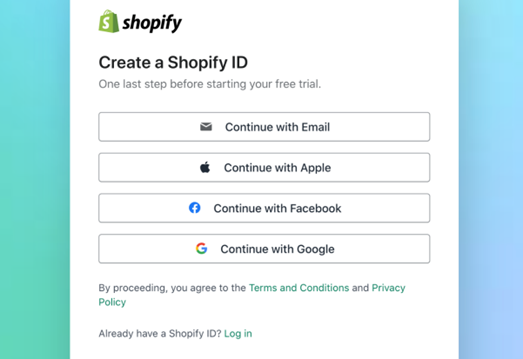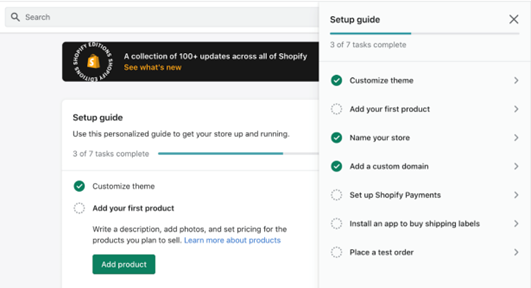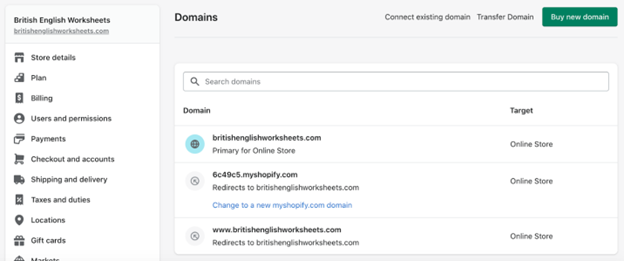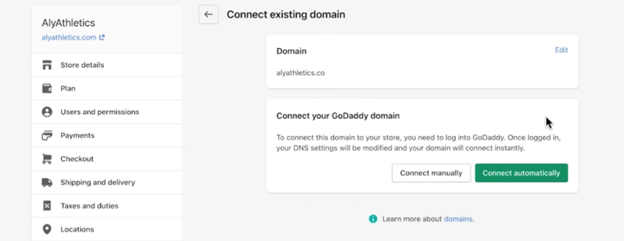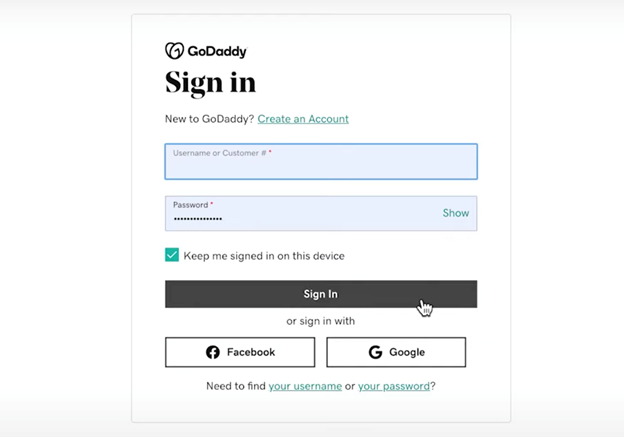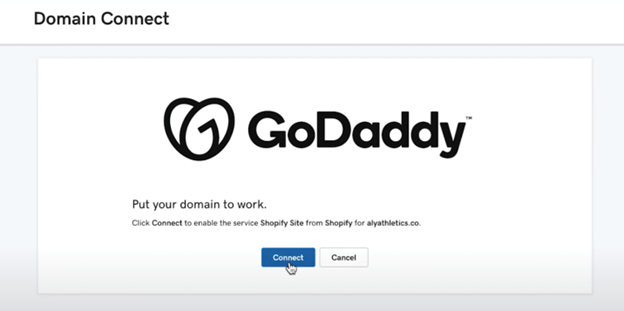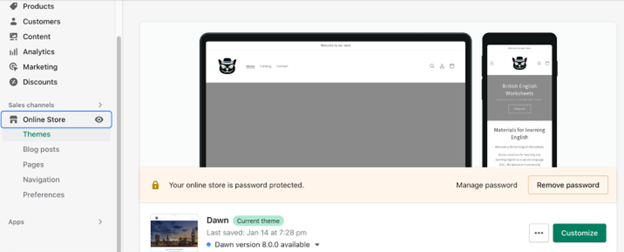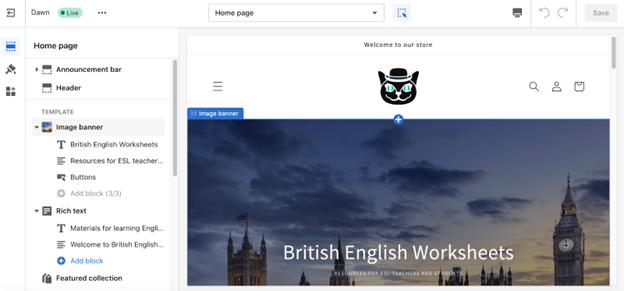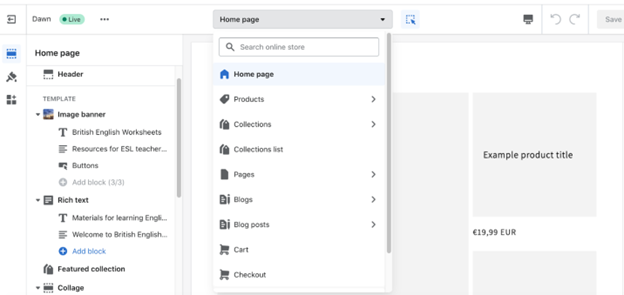no_commission
No comission regardless of your profit
dropshipping_tools
End-to-end fulfillment
pickup_point
Warehouses in USA, Europe, Australia, Japan and UAE
Course 1
Dropshipping
Your Project
So, you want to start your side hustle? Congratulations! Let's get you started with an ecommerce business project that will make you money.
The dropshipping Academy is here to help you step-by-step.
Anyone can begin dropshipping without creating a company or any other requirements. Simply set up an online store, use dropshipping as your supplier, and sell to your customers.

Where to sell?
Choose how you will sell to your digital customers.
These are the most popular options:
- Create a website
- Use online marketplaces
- Use social media
We recommend setting up your own website.
This is the most popular channel for selling your dropshipping products. Not only do you have more control over your own website, but you save money by not paying commissions as you would on other third-party selling platforms.
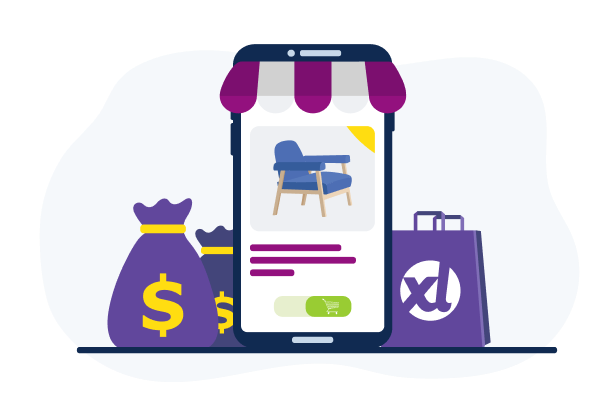
Create your online store
Module 1: Buy your domain name
Before you start building your website, you will need a domain name. This is the unique URL of your website. Normally, this is the name of your dropshipping store or your brand name. It's possible to have more than one domain name and connect them so that they all direct to the same website.
SEO keywords
Using SEO keywords in your domain name helps customers find your website. Think about which SEO phrases that your target audience would use to search for the products you sell. The more accurate your domain name is to these SEO keywords, the higher you will rank on Google's results pages.
For example, if you are dropshipping pet supplies in Australia with the brand name "Soft Paws & Co.," some or all of these would be domain name options:
- www.softpawsco.au
- www.softpawsco.com
- www.softpawsco.shop
- www.petsuppliesaustralia.com
- www.petsupplies.shop
- www.petsaccessories.au
- www.petaccessoriesaustralia.com
Notice how a dropshipping store in the pet niche would use different phrases related to pet supplies and pet accessories. Including the country you sell from is also useful for online customers.
Where to buy your domain name
Once you have your list of domain names, it's time to purchase. These are some websites to use:
- Go Daddy
- Google Domains
- 1&1 IONOS
- Name Cheap
- Name Silo
- Blue Host
You can use a search engine to find other domain name providers.
Do I need to buy a domain name?
For professionalism, it's better to buy a domain name. Website builders give you the option to use a free website URL, however, it will include the name of the website builder you are using.
For example, the pet company mentioned above that decided to use Shopify, would have the option of using the URL, www.soft-paws-co.myshopify.com. To show your customers that you are an authentic and trustworthy online store, we recommend that you buy your custom domain name.
Other benefits of buying a domain name:
- A custom domain name shows credibility
- Part of your personal branding
- Protect your brand's identity
- ·Buy your company name before your competitors
- Reach your target market
- Be memorable
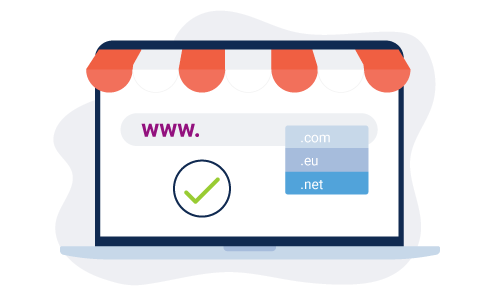
Module 2: Choose your website builder
There are platforms to help you easily build an ecommerce website without any technical knowledge. These are popular beginner-friendly options:
- Shopify
- WooCommerce
- Wix
- Prestashop
- BigCommerce
- Magento
- Opencart
How to choose a website builder
With so many website builders to choose for your dropshipping store, it can be difficult to decide which one is best. To make this decision, it depends on these factors:
- Your website technical knowledge
- Your experience using a website builder
- Your personal preferences for customisation
- Your budget
Each website builder is slightly different. For example, WordPress is a little more technical. WordPress is designed so that you create your content in the back-end and switch views to see how it looks to your online visitors.
Options such as Shopify and Wix allow you to build a website by the easy method of drag and drop. This means you see how your website will look while you are building it.
Many offer a free or cheap trial so you can test a few website builders and see which one works best for you.
We highly recommend you use Shopify or WooCommerce because we have special worldmall plugins with these two partners.
Is your website builder compatible with dropshipping?
It's crucial to check whether the website builder you want to use is compatible with dropshipping. You can see our integrations page for a full list of dropshipping plugins available and which websites they work with.
You will need one of these plugins when you start to build your dropshipping website. It is necessary for connecting your website with dropshipping. These are the features our plugins provide:
- Real-time stock and price updates
- Bulk-import worldmall products to your website
- Automatic order processing
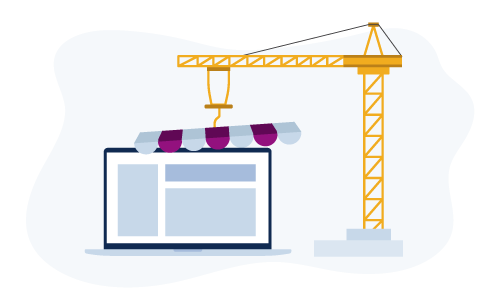
Module 3: Build your webshop
You can create a dropshipping website in less than a day. To see how easy it is, follow our step by step tutorial.
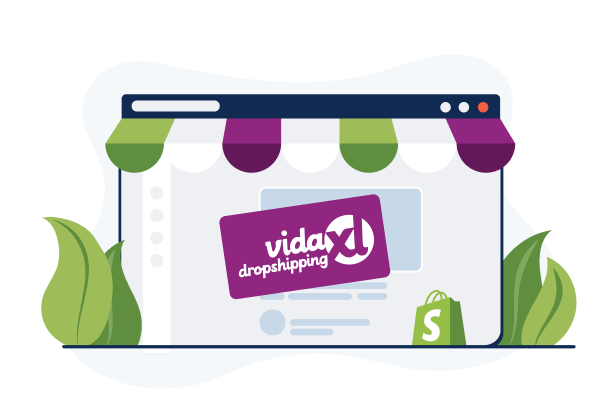
Module 4: Tips for your dropshipping website
- Make sure you have a contact page so customers can send enquiries about your products and their orders. A contact page is essential for customers to trust your brand and build a good reputation.
- Keep it simple. Don't overcrowd your website with too many options in the menu or too much text on each page. Make it easy for customers to find your products and make a purchase.
- Use SEO keywords in your content. To attract more customers, you need to increase your visibility on Google. By using SEO keywords that are relevant to your niche, higher numbers of your target audience will find your website.

Course 2
Find your niche
Module 1: Choosing your Niche
A niche market is a specialized and smaller segment of a market. When you begin your dropshipping business you will need to decide which products to sell and to which buyers.
If you decided to sell every type of toy to every adult buying for a child, you would be competing with a huge number of other online companies.
The cost to compete and to advertise to such a large number of buyers would be very expensive. It is more time and cost-effective to focus on a smaller number of products for a highly targeted group of buyers.
Examples of niche markets:
- Eco-friendly toys for health-conscious and environmentally-aware parents
- Adult and child bicycles and camping gear for families that take bicycle holidays.
- Solid wood bedroom furniture for homeowners that prefer quality and long-lasting timeless pieces for their interiors.
- Reclaimed and recycled furniture for homeowners that want to reduce their carbon footprint.
- Gazebos and outdoor frames for large garden owners and event organizers.
You can find more than 90,000 products at worldmall in 30 categories, such as:
- Home furniture (50,000+ items)
- Garden furniture (20,000+ items)
- Hardware (6,000+ items)
- Pet supplies (2,000+ items)
- Sporting goods (1,500+ items)
- As well as toys and games, vehicles and parts, business and industrial, baby and toddler, health and beauty, and luggage.
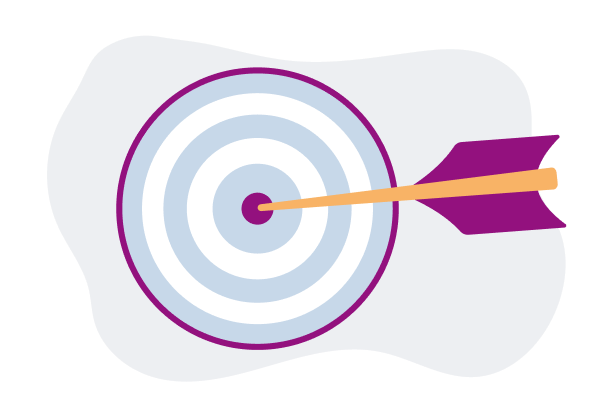
Research your Niche
Before choosing your niche, take some time to do some research to see the competition and if it will be profitable.
You can use online tools to help you:
Google Trends
Google Trends is a free tool to see what people are searching for on the internet. Type in keywords related to the niche you are interested in to find how many people are searching those terms on Google. It also tells you how popular those search terms were over time.
Google Keyword Planner
Another free tool from Google, Keyword Planer gives you data on how competitive search terms are. This will help you see how much advertising will cost to pay for paid adverts on Google and get an idea of how popular these search terms are with online buyers.
Meta Business Insights
Use powerful data from Meta to find out shopping trends on Facebook, Instagram, and WhatsApp. Search forecasts and reports to get an idea of how successful your niche might be based on the behaviours of users across three of the most-used social media platforms.
Social media
Don't sleep on social media as a source of information. Search directly on each platform such as Facebook, Instagram, and TikTok to find out what customers like, the most talked-about products, and topics they care about. For example #TikTokmademebuyit is a trending hashtag for shopping trends.
Emerald Insight
For paid data, try Emerald Insight. It is an academic database to access industry reports such as current online shopping preferences and channels being used.
BCC Research
A paid resource, BCC Research is incredible for up-to-date market analysis and industry reports. This market intelligence will help you identify the strengths and weaknesses, current key figures, and forecasts for global market segments
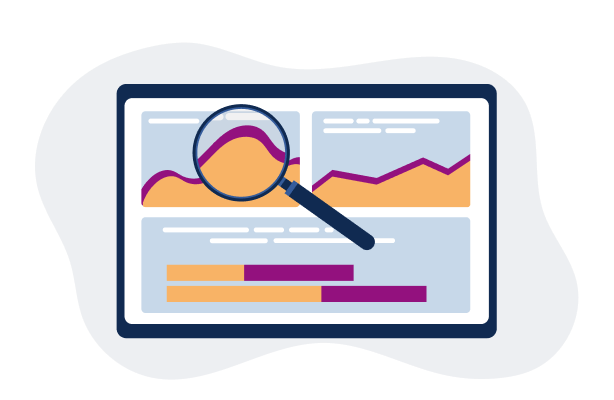
Module 2: Build your brand
You have your website, your products, and your niche. Now it's time to refine your branding to stand out from your competitors and make sure you are memorable.
What is branding?
Your company's branding is not just your logo and business name. It is the look and feel that you present to your customers, it's your reputation in the eyes of the consumer, and how the consumer connects with you.
Why is branding important?
Investing time into your branding will help you build a better connection with your target audience. The more you appeal to your ideal buyer, the more trust they will have in you as a brand, leading to repeat sales, and recommendations of your store to their family and friends.
Invest in your visual content
In today's digital world, brands have learned that customers have high expectations when it comes to ecommerce websites. Online shoppers want an easy, seamless, and aesthetically-pleasing buying experience.
Impress buyers with your looks:
- Use high-quality photos on your ecommerce store
- Create a professional logo
- Include videos to catch your visitor's attention
- Use the same branding across your social media, website, and marketing
Decide your tone
The tone of your brand is the way you speak to your customers. Businesses that specialise in banking and finance, for example, usually have a formal tone with their customers. For dropshippers, this tone can be more casual and friendly. You can choose how humorous, informal, relatable or tongue-in-cheek you want to be.
How to talk to your audience:
- Keep the tone of your content the same for all channels
- Choose a tone that will appeal to your target buyers
- Stay consistent with your brand voice to build familiarity
How do you want your customers to perceive you?
Think about the brands you know. What are the first words that come to mind when you think of them? Are they classy, luxurious, and elegant? Or are they affordable, reliable, and entertaining? Why did you think of each brand this way?
Consider how these brands look and feel, how they speak to their customers, and what methods they use to give their brand this unique personality.
Steps to establish your brand's essence:
- Write a list of the words you want your customers to associate with your brand. This is your brand's personality.
- Based on this, write down how your logo, website, customer service, and marketing should look to match these words.
- What do you think your customers expect from your website and customer service to match the price of the products you offer?
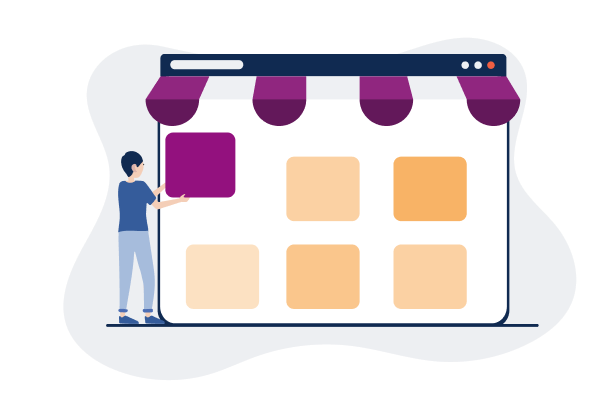
Course 3
Let's WM
In this course we’ll be setting you up with a dropshipping account and preparing for your first sales!
Module 1: How to start?
First, let's set up a dropshipping account for your business.
1. Register on our dropshipping website
- Enter your business details (+VAT number if your business has it)
- Pay first monthly fee
Why do I pay a monthly fee?
The subscription to our dropshipping platform costs 30 USD/month. This includes business support and account management, access to attractive B2B prices on stock, and the cost of customer delivery and returns.
Concerned about commitment?
If you don't place orders within your first month and wish to cancel, your subscription will be refunded. You can close your account at any time after that.

2. We verify your account
- Our support team will verify and approve your account within 2-5 business days.
- You will receive an activation email with your login details and product feed.
What is a product feed?
We provide you with a data feed updated in real time (CSV and XML file):
New products (updated every week) with product description in your webshop language and images, prices (can vary every day depending on supply and demand) and stock (updated every 15 minutes).

3. Start selling!
- Open our product feed and make a first selection of the products you would like to sell.
- Integrate them to your webshop and set up your prices.
How do I integrate the products in my webshop?
Combine your own implementation system with ours to synchronize product updates and orders.
Skip ahead to Module 2 for instructions on how to do so

4. Get support
- Our support team will help you with any technical or order requests.
- Once you work with us long-term, an account manager will assist you with building a business strategy. You can expect to receive a monthly sales report, product suggestions for the next season, and data from our trend reports.
Download our full Registration manual

Module 2: Set up
How do I integrate worldmall products into my webshop?
1. Real-time data feeds
We provide you with a data feed updated in real time (CSV or XML file):
- New products (updated every week) with product descriptions in your preferred language, images, and number of product packages
- Prices (can vary every day depending on supply and demand)
- Stock (updated hourly)
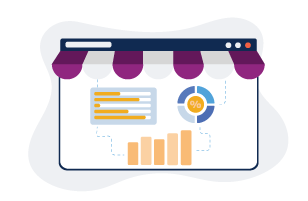
2. API
Use API to connect your webshop to dropshipping for these benefits:
- Automatically send your orders to dropshipping
- Retrieve up-to-date stock prices
- Receive tracking numbers and order invoices
What is API?
Here is a quick basic explanation:
Application Programming Interface (API) is a set of functions to connect separate software platforms.
This makes it possible for the latest data such as stock levels and pricing to be sent from a supplier's database (ours) to your dropshipping store.
How can I use API?
Once you will have successfully created you dropshipping account, you will be able to request your API Token. We will give you access by enabling your API token directly in your account.
After that, you will be able to link our API with your webshop, using the API token provided.
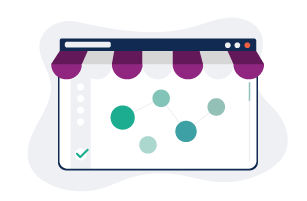
3. Connectors
The easiest way to synchronize your ecommerce store with data from worldmall is to use our recommended plugins. This saves you time as the product data feeds are sent directly to your store automatically.
The advantages of using worldmall plugins
SHOPIFY:
- Import the (full) assortment of worldmall based on the selected category
- Import product content including images, descriptions, and prices
- Determine your own fixed or variable margin or use the worldmall advice price
- Synchronize stock amounts automatically and in real-time
- Synchronize prices automatically and in real-time
- Send orders automatically to worldmall for shipment (coming soon)
WOOCOMMERCE:
- Choose which product categories you want to import from worldmall to WooCommerce.
- Set your margin as a percentage or fixed amount or choose worldmall's recommended price.
- There's no need to worry about creating product categories as these are imported with the products.
- Incoming orders will be transferred to worldmall automatically. This means your entire worldmall dropshipping process is automated.
- Stock updates will be done in real-time, with a maximum delay of 5 minutes.
- Product images are not uploaded into WooCommerce, to keep your webshop clean and fast.
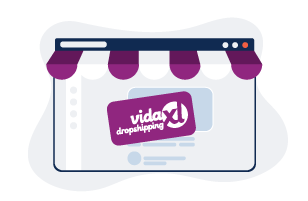
Course 4
How to set price margins
Carefully choosing what price to sell your dropshipping products is key to making sure you attract sales while making a profit. To do this, you will need to consider your operating costs and external factors that will have an influence on your optimum price point.
Module 1: Factoring in business costs
As with any business, you will have ongoing costs to pay to keep your business up and running. Covering these costs comes from the revenue you make from your product sales. So, factoring in these expenses will allow you to make a profit. These include:
- Cost of goods sold
- Marketing and advertising costs
- Website and hosting costs
- Delivery costs (free with dropshipping)
- Dropshipping supplier fees ($30pm with dropshipping)
1. Cost of goods sold
The cost of goods sold (COGS) is the B2B price of the product that you buy from your supplier. It is the direct costs required to produce a product.
If you were to produce a product yourself, you would need to cover the cost of manufacturing. This would be the cost of machinery and equipment, materials, labour costs, packaging, and storage, for example.
2. Marketing and advertising costs
The largest part of your dropshipping business expenses will most likely be for your marketing and advertising campaigns. Search engine and social media paid ads are normally the biggest investment per month.
Especially in the early days of your dropshipping store, you will notice higher costs per campaign as you begin to test which ads are the most effective.
Email marketing, influencer marketing, and paid content marketing are also costs to pay for if they are in your digital marketing plan.
3. Website and hosting costs
Building and hosting a dropshipping website will require part of your budget. Consider these fees:
- Ecommerce website monthly subscription (e.g. Shopify, WooCommerce)
- Annual domain name payment
- Payment provider fees (e.g. PayPal, Shopify, Stripe)
- Plugin subscriptions
- Website store theme
- Professional logo design
Some of these are one-off costs, for example, your logo design might not need to be updated for several years. Website builder fees have monthly or annual payment plans and your domain name will be paid for once every 1-2 years.
4. Delivery costs
Many dropshipping suppliers charge delivery costs to send products to your customers. However, the delivery costs for dropshippers with dropshipping is free. This covers all countries that are part of our program. Returns are also free for all countries with the exception of Australia and Norway.
Australia
If the customer gives the return reason as "Not As Expected," then the original shipping and return costs are deducted from the refund (with the exceptions for returns from Sydney, Melbourne, and Brisbane metro areas).
Norway
If the customer gives the return reason as "Not As Expected," then a return fee of 300 NOK will be deducted from the refund.
For more information, please see our returns policy.
5. Dropshipping supplier fees
What are the fees associated with your dropshipping supplier? This will vary depending on the supplier you choose.
With dropshipping, our dropshippers don't have to worry about any surprise costs. Simply pay a flat subscription fee of $30 per month. What's more, enjoy 0% commission regardless of your sales volume of worldmall products.
Are there other factors that affect pricing?
Besides your operating costs, there are other external factors to consider. These will impact the best price point for your dropshipping products.
Demand fluctuations:
The supply and demand of your products can be important when deciding a price point.
If the demand is high, you can take advantage of this and price slightly higher.
If the demand is low, you can entice sales by lowering your selling price.
Perceived value:
How desirable do consumers see your products?
The perceived value of your product can depend on whether it is affordable or luxury, the quality of materials used, and how original the product is.
Perceived value is how much consumers are willing to pay for your goods.
The target buyer persona:
Think carefully about who you are targeting:
- How much money do your customers earn?
- How passionate are they about the type of product you are selling?
- Do they value higher quality goods or budget items?
The competition:
Don't forget to check what your competitors are offering.
- What prices are they selling their products?
- What offers and bundles are they advertising?
- How much are they charging for delivery?
Consider whether you want to match their prices, lower yours or charge higher but offer value to your customers in another way (e.g. excellent customer service).
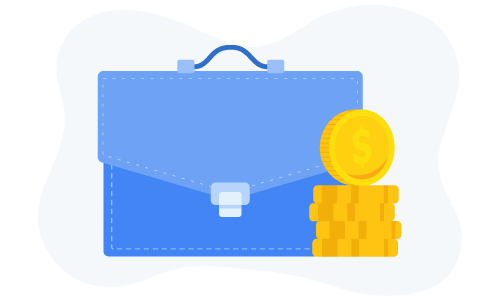
Module 2: Creating a pricing strategy
Can I just estimate a price for my products without a strategy?
In theory, yes, you can make a vague guess at how much to price your products. But, it's a very big risk. If you get it wrong and make few sales, you might not break even.
To prevent your dropshipping business from failing, we recommend that you take some time to consider various pricing strategies. Don't base your retail price on your competitors price alone!
How do I choose the right pricing strategy?
There's no perfect pricing strategy for dropshipping. Instead, you will need to make a decision based on the type of products you are selling and reviewing the factors mentioned above. Whether you are offering low-ticket, medium-ticket, and high-ticket items will also affect your pricing formula.
Then, once you see how your products are selling in the market, you can make adjustments. See below for our explanation of low, medium, and high-ticket items.
What types of pricing strategies are there?
You might be surprised to know there are many pricing strategies to choose from. We will talk you through the relevant ones for dropshipping, which include:
- Fixed markup on cost
- Tiered markup on cost
- High-low pricing
- Bundle offers
- Psychological pricing
It's possible to combine some of these pricing models together, so don't feel obliged to strictly stick to only one.
1. Fixed markup on cost
Also known as cost-based pricing or cost-plus pricing. A fixed markup means that you add a specific amount to each product at the price you pay your supplier (B2B price).
This will give you a fixed profit margin. There is no set average markup price to go by, since this figure depends on the type of product you are selling.
For example, imagine that the average B2B price of your products is $15. You might decide that you want to add a fixed markup of $15 to cover the costs of your business expenses and a small profit margin. You would then sell these products at a retail price of $30.
Likewise, you can add the fixed markup as a percentage. Taking a look at your operating and marketing costs, you may decide that you need to markup your products by 80% to make a profit. A product with a B2B price of $15 would then be sold to consumers for $27.
2. Tiered markup cost
This is the same as the fixed markup pricing strategy, except that you vary the markup percentage depending on whether it is a low-ticket, medium-ticket, or high-ticket item.
A low-ticket item usually has a retail price of $50 or less. Consumers spend less time considering whether to purchase and often impulse buy. A high margin is applied, which might be around 80-150%.
A medium-ticket item may have a retail price of $60-180. A price markup is typically around 40-80%.
A high-ticket item is the most expensive retail product to sell, at least $200. Consumers spend more time weighing the pros and cons of buying a product in this price range. The price markup is smaller at around 20-40%.
3. High-low pricing
High-low pricing defines the retail price with the intention of offering it at a sale price after some time. This is suitable for dropshipping products such as seasonal goods, for example, swimming pools and garden firepits.
So, a product will initially be sold at a higher price and then as demand decreases, the price will be reduced.
If you were to sell garden swimming pools just before summer, the retail price would start high to meet high demand. At the end of the summer season, this item would be discounted to increase sales as demand drops.
4. Bundle offers
If you want to boost interest in your products and get your customers to spend more, try bundle pricing. You have likely seen it in shops online and offline, where several products are sold together as a pack at a reduced price.
The retail price for the bundle is a great deal for consumers as they save money on what they would have spent if they bought the items separately.
Bundle offers work for many types of product categories including furniture, decor, children's toys, pet supplies, and sports equipment. Not only does it help you to sell quickly, but you also save on marketing costs.
If you were to sell the products on their own, you would need to factor in a marketing budget for each. However, in a bundle, you are able to make the sale without paying for extra Facebook or Google ads.
With this strategy, you can sell multi-packs of the same product or put matching items together. For example, you might decide to sell a garden table, sofa, and chairs as a bundle.
5. Psychological pricing
Finally, there is psychological pricing, which is a technique used almost everywhere. The idea is to lure buyers into a sale by using retail prices that end in odd numbers. The most famous, and arguably the most effective, is a number ending in 99. For example, $15.99 instead of $16.
Consumers feel like they are getting a better price but, in reality, it's only a saving of a few cents. You can experiment with how you round your retail prices. By testing $15.95, $15.99, $15.97 or $16 for items on your dropshipping store, you can see at which price your customers respond the best.
Another tactic is to include the delivery costs into the product price. Many consumers will abandon their baskets if they feel the delivery cost is too much on top of their purchase.
Thankfully with dropshipping, delivery is free of charge to our dropshippers. This makes it easy for you to pass on this saving to your customers.
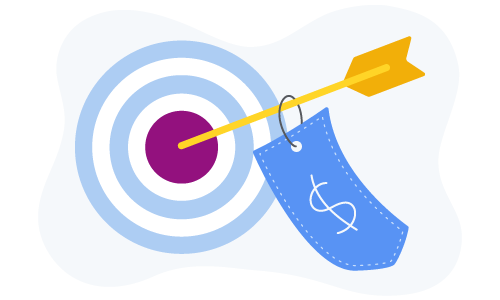
Course 5
Starting a marketing plan
The goal of marketing is to help you attract customers to your store. A dropshipping business can use online marketing channels to reach its audience. These channels are:
- Pay-per-click (PPC) adverts
- Email marketing
- Social media
- Influencer marketing
- Content marketing
- Search engine optimisation (SEO)
Module 1: Pay-per-click (PPC) adverts
One of the quickest ways to promote your product or store is by purchasing PPC adverts. These are the sponsored ads at the top of Google after you have searched for something.
Benefits of PPC ads
- Easy to set up and create yourself
- Boost traffic to your website in a short amount of time
- Target a very specific audience
- Convert sales with the right wording
- Measure the results of your adverts
Budgeting
- We recommend you start with a small budget
- Test your ads before increasing your ad spend
%20adverts%20.png)
Module 2: Email marketing
Email marketing is the method of promoting a product or offer by sending emails to your customer base. It's also a trusted and affordable way to update customers or build customer relationships.
What are the benefits of email marketing?
1. Email has an impressive return-on-investment
According to a report by Omnisend in 2022, email marketing has an average ROI of $40 per $1 you spend. This is the highest ROI of any marketing channel.
2. A low-cost marketing technique
The average cost for email marketing can be $300-500 per month for a medium-sized company using an agency. A large business could spend up to $2000 per month.
If you were to create email campaigns yourself, this could be completely free. Considering the ROI rate, email is an extremely cost-effective way to promote your business.
3. Sending personalised emails has big advantages
Personalisation in marketing is the fast lane to better sales. In 2023, McKinsey research suggested that personalisation reduces customer acquisition (the amount of money needed to spend on marketing per customer that leads to a sale) by 50% and improves revenues by 5-15%.
4. High conversions when customers opt-in
The open rate and click-through rate is notably higher when customers give permission to receive marketing emails. An ROI of $40, as mentioned before, applies only to emails where customers opted-in.
This compares with the low average open rate of non-permission emails, which is around 5%. Sending promotional emails without permission from the recipient is in breach of the General Data Protection Regulation (GDPR) law in the EU.
5. Use email automation to your advantage
Email marketing software sends emails to customers at every stage of the customer journey. Set up automation to trigger welcome emails when new customers sign up, abandoned baskets when customers leave the website, and product recommendations to encourage repeat sales.
Automatic personalisation of emails also improves conversion rates. So much so, that the global revenue of the customer experience personalisation and optimisation software industry will be worth USD 11.6 billion by 2026, says Statista.
6. Easily measure your email marketing performance
Automated email marketing software measures your email data for you. This makes it easy to objectively see what does and doesn't work in your email marketing strategy, understand your audience better, and maximise your profitability.
The key metrics include:
- Open rate - the percentage of emails that are opened.
- Unsubscribe rate - the percentage of email recipients that unsubscribe after opening a promotional email.
- Click through rate (CTR) - the percentage of email recipients that clicked on at least one link in the promotional email.
- Conversion rate - the percentage of email recipients that completed a desired action (e.g. made a purchase).
- Bounce rate - the percentage of emails that were unable to reach the recipient's inbox.
- Email forwarding/sharing rate - the percentage of email recipients that clicked the "forward to a friend" or "share this" buttons.
- Overall return on investment (ROI) - the total revenue made from your email marketing efforts divided by the total spend.
7. Customers prefer email
Email marketing is the preferred method that customers want to hear from brands. Calls and texts are too invasive but emails are easy to manage.
According to The Future of Commerce: 2023 Edition by Square Up, 60% of US consumers want to hear from brands by email. This compares with 46% who prefer social media.
In the UK, 57% of British consumers read more than half of the emails they receive, says data from the Data & Marketing Association in 2019.
How to create an email campaign
1. Decide on your marketing goals
There are a few things to do before you start to pen the best promotional email ever sent. First, think about what your email is for:
- The purpose - e.g. advertising a particular product, promoting an offer, sharing a discount code.
- The audience - e.g. only customers that have made a purchase in the last 6 months, new customers, customers that abandoned their basket.
- The call to action (CTA) - what do you want the email recipient to do? e.g. sign up, go to a landing page, complete their checkout.
2. Think about the number of emails in your campaign
There are different types of email formats for marketing. These include: newsletters, promotional email shots, and order information.
For a marketing campaign, a series of short email "shots" are usually sent over the course of weeks. This is important as we take into account how quickly the average email inbox is filled with competitor emails.
3. Choose your email marketing software
It's possible to send marketing emails manually but as your email list and business grows, it's not feasible to use this method. There are many email marketing software companies on the market to choose from.
They are worth the investment to access automation, personalisation, and analytics features. Building your emails is no longer complicated by using "drag and drop" tools when creating an attractive design.
Here are some examples of affordable email marketing software companies that are suitable for a startup dropshipping business:
- MailerLite
- SendGrid
- Sendy
- Brevo
- CakeMail
4. Write the contents
Now it's time to start building the email content. The structure of a marketing email is typically as follows:
- Subject - Write an attention-grabbing subject line to entice the reader. Remember that you need to compete with a tonne of promotional emails that are screaming to be opened in the inbox of your email recipient.
- Preview text - Appears below the subject line. The display limit is around 35-90 characters.
- The tone - Match the tone of your emails with your branding. Use puns and light humour if it is in line with your other marketing materials.
- Header - This is the first thing your customer will read in the main body of your email. Make it short and eye-catching.
- Main contents - Write persuasive copy to push your customers to do something, whether that is to make a purchase, leave a review or advertise a new line of products.
- Call to action (CTA) - Include a command to prompt your customers to take action after reading your email. Include at least one at the end of your main body contents. E.g. shop now, view order status or complete checkout.
5. Make it pretty
It's a good idea to pay attention to the overall look of your email marketing campaigns. Customers are more likely to respect your brand if you use clean graphic design and attractive colour palettes.
- Images - Focus your email content around high-quality photos and illustrations. Pictures grab attention better than words, so use this to your advantage. Customers don't want to read too much.
- Design - Think carefully about the placement of images, text, and call-to-actions. It's helpful to make text large and easy to skim read. Use bright colours such as yellow or red to advertise a sale.
- Gifs - Try using movement in your emails. Gifs make your content stand out and add interest.
6. Send and track
After triple-checking your email for good grammar, spelling, and working links, send your email to your desired list segment. Track the success of the marketing campaign by looking at the open rate, click through rate, bounce rate, and conversion rate.
These metrics will be on the dashboard of your email marketing software account, which you can export to a spreadsheet if you want to compare against previous campaigns.
Further reading
How email marketing is the most powerful tool for boosting sales
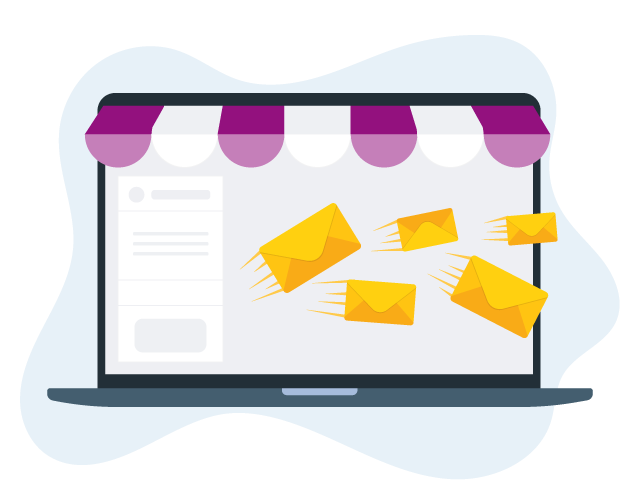
Module 3: Social media marketing
Social platforms such as Facebook, Twitter, LinkedIn, Instagram, and YouTube are used by brands to advertise their services and manage customer support. It is a preferred method of communication as consumers can keep up-to-date with businesses and access quick responses to queries.
Benefits of social media marketing
- Grow brand awareness
- Increase traffic to your dropshipping store
- Interact with customers
- Appear in Google search results
- Promote events, sales, new products, and flash offers
- Get feedback from customers
- Create paid social media ads to reach more people
- Make use of social media metrics e.g. Facebook Insights
Budgeting
Here are some recommendations for costs to include in your social media marketing budget:
- Professional photography
- Product video production
- Graphic design
- Influencers
- Content writing
- Paid social media ads
- Social media marketing software
How to create a social media campaign
1. Determine the marketing objectives
As you may have noticed, all marketing campaigns start with the marketing goals. Then, you can choose the appropriate steps to achieve them. Your social media marketing objectives might be:
- Generating leads and sales
- Growing brand awareness
- Building your email list
- Encouraging community engagement
- Driving traffic to your dropshipping store
2. Research the competition
Before you dive into your campaign, it's helpful to see what your competitors are posting on social media. Take note of:
- How your competitors adapt their content to each social media platform
- How frequently they post content
- What type of content they are sharing
- What tone they are using
- How they interact with customer comments
- Whether they offer customer service support on social media
This step is handy to get an idea of what works for your competitors and how you can stand out from the crowd.
3. Plan the content
Tailor your social media marketing content based on the objectives you have chosen in step 1. This is an example social media content plan if your goal is to increase your brand awareness:
- Avoid only promotional content
- Be authentic and show some personality
- Collaborate with other brands
- Adapt your content to the social media platform
- Share only engaging and useful content
- Be visually appealing with high-quality photos and videos
4. Appeal to your target audience
Your social media marketing campaign will fall flat if you don't know your target audience. Age, interests, geographical location, personality traits, attitudes, hobbies, education, and household income are some psychographics of your target audience to consider.
All this data can influence how they like to interact with brands and what content they find appealing.
How to find out about your target audience:
- Customer surveys
- Customer reviews and feedback
- Customer comments on your social media posts
- Basic data from customer online orders
- Testing content on social media to see what gets better engagement
5. Use all the social media platforms
Take advantage of as many social media platforms as you can. If you don't have the time to run social media posts on every channel, try to create an account for each one.
This will ensure you are the official owner of your preferred brand name on that channel with the basic company information and link to your dropshipping store.
Remember that social media pages are perfect for link building - driving web traffic to your online store and increasing your search engine optimisation (SEO).
The more social media platforms that you use to post content, the greater the size of your audience.
Your customers will have different preferences for which social media channel they enjoy using the most. Reaching them on as many as possible caters to their needs and increases your chances of making an online sale.
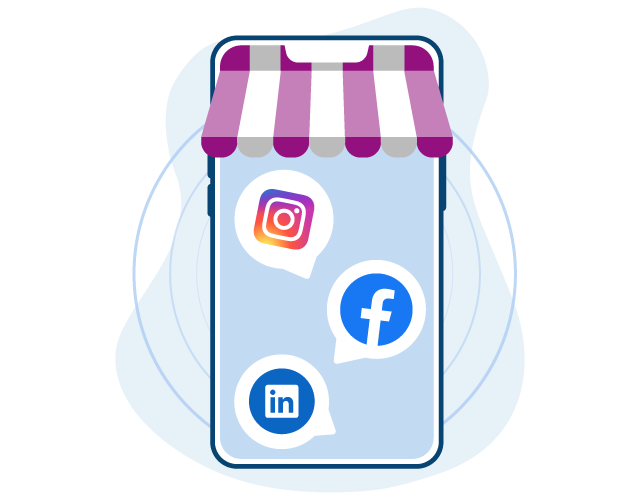
Module 4: Influencer marketing
Influencers are digital creators. They have an online community with loyal followers who trust their opinions and product recommendations.
How does influencer marketing work?
Influencer marketing is a form of online paid advertising. It is a way to promote brand awareness, reach a new target audience, and increase sales conversions. These are a few ways to use influencers:
- Product gifting: Brands send free products to influencers as part of their public relations (PR) efforts. The influencers are not obliged to promote or show the products to their audience.
- One-off fee for content: Brands can pay influencers for sponsored content. This could be a product mention or review in a YouTube or TikTok video, Instagram Story, or a mention or tag on a Facebook, Instagram, or Twitter post, for example.
- Performance-based: Pay influencers depending on the success of their sponsored content. This can be measured by cost-per-engagement, cost-per-acquisition, and cost-per-click.
- Affiliate partnership: Influencers can earn a percentage of profits generated from the sale of your products. They usually have a unique discount code or link for their audience to use.
Is it worth using influencers?
There are mixed opinions about whether social media influencers are still relevant and trusted by consumers. A recent small study by EnTribe in 2023 found that almost 90% of 1,000 survey respondents are fed up with sponsored influencer content.
The study suggested that "86% are more likely to trust a brand that publishes user-generated content, compared to just 12%, who are inclined to purchase a product promoted by an influencer."
However, another study of 1,000 participants by Matter Communications in 2023 found completely opposite results. 81% of consumers said that they were tempted to purchase an item after seeing friends, family or influencers post about it.
According to the survey, these are the most popular social media influencers:
- Relatable personalities (61%)
- Expert personalities (43%)
- Just-for-fun personalities (32%)
- Aspirational personalities (28%)
They note that only 11% of participants said that they prefer and trust celebrity influencers.
How much to spend on influencer marketing
You can find an influencer to suit your dropshipping marketing budget. Influencers with large audiences will charge more and smaller influencers will be more affordable.
YouTubers are more expensive than on other social media platforms. Their rates greatly depend on their engagement rates per video and their number of subscribers.
These are the types of influencers and their costs*:
| Type of influencer | Number of followers | Average cost per Instagram post | Average cost per YouTube video |
|---|---|---|---|
| Nano influencers | Less than 1,000 | $10-100 | $300 |
| Micro influencers | 1,000-100,000 | $100-500 | $900-2k |
| Macro influencers | 100,000-1 million | $500-5k | $3k-5k |
| Mega influencers | More than 1 million | $5k-10k | $4k-20k |
*Based on data from Influencer Marketing Hub (2022), Klear (2019), and MySocial (2022).
Typically, brands pay influencers $2,000 per 200,000 followers.

Module 5: Search engine optimisation (SEO)
SEO is the marketing practice of improving the visibility of your website on search engines. For internet users to find your dropshipping store within the first 2-3 pages of Google is prime online real estate.
Why does SEO matter for a dropshipping business?
When your dropshipping store is easy to find on the internet, you will have a higher rate of traffic and online visitors. This means more sales and more revenue. SEO is crucial for long-term ecommerce success!
How to improve the SEO of your dropshipping website
Use keywords
Customers can only find your website if you appear in Google with the keywords they are searching for. Think about what words or phrases someone would associate with your products.
For example, a customer who wants to buy a baby cot would likely search for: "baby cot," "baby bed," "baby cradle," or "baby crib."
How to choose keywords:
- Use Google Adwords to find relevant search terms.
- Use Google Trends and Google Keyword Planner to see popular keywords for free.
- Think like a customer and find the search intent for your target audience
- See what your competitors are doing by researching their paid ads and the keywords in their content.
- Make use of paid keyword tools like Ahrefs and SEMrush..
" target="_self" data-link-type="external" data-link-label="How to do keyword research for dropshipping Google Ads" style="color: rgb(17, 85, 204);">How to do keyword research for dropshipping Google Ads
Where to use your keywords:
- In your meta description: this is the description text for each of your web pages that requires 140-160 characters.
- In your title tag: this is the text that requires 50-60 characters for each web page.
- In your article title: this is the title headers that you use in your website's content.
- Within the first 200 words of your content: whether it's a blog post or a web page, using keywords in the first few sentences makes a difference.
- Place keywords naturally throughout your content without overusing them.
- In the last 200 words of your content: just like you need to use the keywords in the first 200 words.
Link building
Link building is when you have other websites link to your dropshipping store. These are known as inbound links, which are part of external link building.
When other websites link to yours, not only does it generate more traffic to your website, but it is one of the major ways that Google ranks your SEO.
There are 4 ways to generate inbound links:
- Manually add links to websites and online business directories
- Ask website owners if they can include a link to your website
- Pay for a link to your website if it isn't offered for free
- Create quality content such as blog articles to increase the chances of other people linking to your website organically
Social Media and Google Ads
Pay for adverts on Google and social media such as Facebook, Instagram, YouTube, Twitter, and TikTok to improve your website traffic and SEO ranking.
These pay-per-click (PPC) adverts don't directly help with your SEO however, these are some indirect benefits:
1. Consumers who saw your paid ad will be more likely to visit your website as you have improved brand awareness
2. Consumers may wish to visit your store organically after viewing your advert, instead of clicking on the paid ad.
3. The increased website traffic from the paid ad will increase the exposure your website has from social media coverage.
Further reading
%20.png)
Course 6
Online marketplaces
Dropship without creating an e-commerce store. Many successful dropshippers choose to be third-party sellers on online marketplaces. Examples include Amazon, eBay, Allegro, Bol, and Carrefour.
What is an online marketplace?
An online marketplace, sometimes known as an electronic marketplace, is an ecommerce site. It is defined by two criteria:
- A wide variety of products available to purchase
- There are third-party sellers
This type of website allows consumers to browse a large number of products from many different sellers.
Why do consumers like online marketplaces?
Digital shoppers enjoy using online marketplaces for these reasons:
- It's easy to compare products
- It saves times searching for the best deal
- Products have to pass quality standards and delivery times
- A larger choice of products
- The option to buy from overseas sellers
- Bigger online marketplaces can offer better discounts
Why sell via online marketplaces?
| Pros | Cons |
|---|---|
|
|
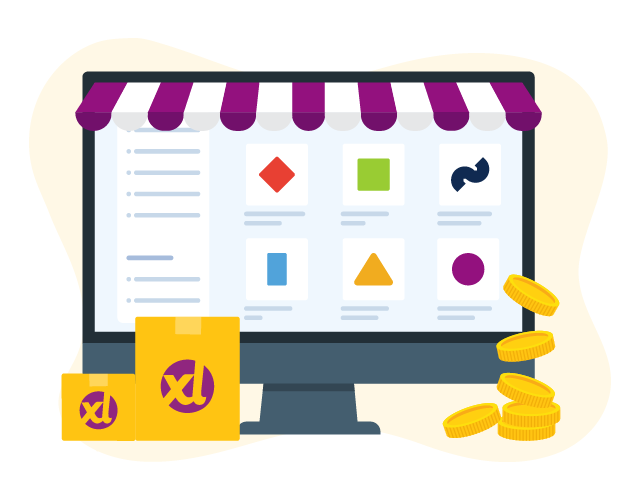
Dropshipping with Amazon
As of 2023, Amazon has more than 185 warehouses globally and operates in over 23 countries across five continents. In 2022, Amazon reported in their blog that it had 300 million active users. The American retailer hit USD 514 billion in 2022 in net sales worldwide, according to Statista.
New dropshipping rules
Recent changes in Amazon's terms and conditions in 2023 state specific rules for Fulfilment By Merchant (FBM) sellers. These are:
- You must be the seller of records that appear on packing slips, invoices, and external packaging. It is strictly prohibited for any other name or company branding to be used that isn't listed as the seller of record.
- Remove any packing slips, invoices, or external packaging that identifies a third-party dropshipper prior to shipping the customer order.
- You must be responsible for accepting and processing customer returns.
- Comply with Amazon's seller agreement policies (check for your specific country).
Further reading:
Steps for setting up an Amazon store in the UAE
Amazon Prime Day: What it means for your dropshipping store and how to take advantage of it
Dropshipping with ManoMano
ManoMano is a French online marketplace with a presence in Europe, the Middle East, and Africa (EMEA). It specialises in DIY, hardware, furniture, garden, sports equipment, and pet products.
According to their website, ManoMano has 50 million online visits each month and 7.3 million active DIY, home and garden customers (as of 2023).
To start dropshipping with ManoMano you need to create a selling account. These are the requirements for becoming a seller:
- You must sell DIY, home and garden goods
- Respond to customer messages within 24 hours
- Send tracking identifiers to customers
- A customer refund rate of less than 3%
- Offer competitive prices
- Submit 3 photos per product and description for the catalogue
- Non-EU sellers need a European tax code and sell from European or ManoMano warehouses
- UK sellers must have a UK tax code and sell from the UK or the EU
The ManoMano selling terms are dependent on the country:
- Payment of a monthly seller subscription
- Agree to the ManoMano commission rate (12-20%)
- Taxes are not included (price of the product plus shipping costs)
Create a seller account on the ManoMano website according to the country where you want to sell.
Further reading:
How to sell on ManoMano: An online marketplace guide
Dropshipping with Bol.com
Bol.com is a Dutch online marketplace with a presence in the Netherlands and Belgium. It sells books, music, toys, sports equipment, furniture, garden, baby, pet, and beauty products. According to their website, Bol.com has 13 million active customers, 35 million items online, and 52,000 sellers (as of 2023).
To start dropshipping with Bol.com you need to create a selling account. These are the requirements for becoming a seller:
- Be based in the EU
- Minimum sales potential of $500k in the first year
- Excellent record of sales in the international marketplace
- Offer customer service in Dutch
- Agree to use the Bol.com API to integrate products
Create a Bol.com seller account here.
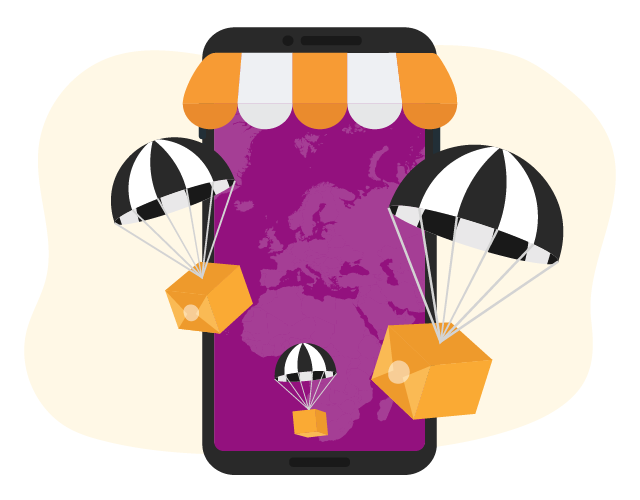
Course 7
What is COD?
What is cash on delivery (COD)?
Cash on delivery (COD), also known as collect on delivery, is a payment method used by some ecommerce retailers. It allows the customer to order online but only pay once it is delivered to their door.
How does COD work?
This payment method has various rules, depending on the provider. In some cases, customers don't have to pay immediately upon receiving their goods. They can decide after checking their purchase and trying them on whether or not they will keep them.
Deposite
Often, a deposit is made by the customer at the time of purchase. This is to cover the risk associated with customers receiving their goods but not paying.
Leaving card details
Alternatively, card details are given at checkout so the retailer can charge the customer if no payment is made after delivery.
Delivery payment
Some businesses charge for the shipping only and allow customers to pay for the product once delivered.
Can customers only pay with cash when using COD?
Unlike the name suggests, there are different payment options for COD. These include cash, card, mobile, bank transfer, cheque, and digital wallet.
What are the advantages of COD?
The benefits of COD are:
- It offers a flexible payment option for the customer
- Attracts a larger customer base
- The customer can review the product before purchasing
- No dependency on card payments
- No risk of online credit card fraud if using cash
What are the disadvantages of COD?
The downsides of COD are:
- No guarantee that the customer will pay
- Possible high return rates
- Extra preparation for the business
Can I offer cash on delivery with dropshipping?
At this time, dropshipping doesn't offer the option for cash on delivery with our delivery carriers.
To let your customers pay by COD, you will need to have your own warehouse and delivery carrier. When your customer places an order, you will send the worldmall package to your warehouse address. From here, you would send the package using your own shipping methods that support COD.
Where is cash on delivery popular?
Asia and the Middle East predominantly use cash on delivery for online purchases.
According to a G4S report, 75% of online orders in these geographical regions are paid cash on delivery.
This table shows some countries that have a high preference for COD as a payment method.
| Rank | Country | Popularity | Source |
|---|---|---|---|
| 1 | Vietnam | 90% | Asian Banking & Finance, 2017 |
| 2 | Romania | 78% | Cash Matters, 2021 |
| 3 | Indonesia | 65% | Asian Banking & Finance, 2017 |
| 4 | Bulgaria | 64% | Cash Matters, 2021 |
| 5 | Slovakia | 64% | Statista, 2021 |
| 6 | India | 62% | Rakuten Insights, 2022 |
| 7 | Pakistan | 58% | Checkout.com, 2022 |
| 8 | Malaysia | 51% | Asian Banking & Finance, 2017 |
| 9 | Hungary | 50% | Statista, 2023 |
| 10 | Thailand | 49% | YouGov, 2023 |
| 11 | Philippines | 47% | Asian Banking & Finance, 2017 |
| 12 | Jordan | 45% | Checkout.com, 2022 |
| 13 | Egypt | 38% | Checkout.com, 2022 |
| 14 | Qatar | 22% | Checkout.com, 2022 |
Course 8
Ecommerce website design
How to improve your website for maximum sales
An ecommerce website should be designed specifically for online consumers. This means, focusing on what online consumers need from a website to make it more convenient for them to browse and purchase.
Factors to consider:
- Who is the target audience?
- What do they need to do on the website?
- What will make it easy for them to do this?
- How can the customer journey be simplified?
- How can purchasing be as easy as possible?
Website user experience
Adjusting your website design to be more comfortable and convenient for your target audience is called improving the user experience (UX). It refers to the interaction a customer has with your brand and website.
Best practices for UX:
- Simplicity works best as customers want information and products quickly without being distracted.
- Include a navigation bar so website visitors can easily find what they need.
- Don't clutter your website with too much text (website visitors usually skim-read).
- Don't clutter your menus with too many options.
- The website should load almost immediately to prevent visitors from leaving in frustration.
- Design your website around the customer and how they will use your ecommerce store (less talking about the company and more function for the user).
Website speed
According to Google and SOASTA Research in 2017, as many as 32% of online visitors will leave your website if it takes more than 3 seconds to load. Check your website speed for free using one of these tools:
The home page of a website gives you a few seconds to impress online users. It's a chance to make it clear what you sell and why they should choose you over your competitors. If your home page is interesting to online users, they are more likely to stay, browse, and make a purchase.
1. Start with an eye-catching headline
This could be an introductory offer, a seasonal offer, or a summary of your services (or brand tagline) to draw online users in. It doesn't need to be directly at the top of the home page. It could be beneath your top menu and logo, but still "above the fold" (the top section of your web page before the user has to scroll down to see more). For example:
- 20% off your first order
- Black Friday deals
- Cyber Week deals
- The Christmas shop is open
- Your next adventure starts here (e.g. for cycling or camping gear)
- Toys for smart kids (e.g. for educational toys)
Don't forget to show a call-to-action (CTA) alongside your headline. These are buttons with a link to direct your customers to the relevant web page. For example:
- Shop now
- Browse deals
- Browse offers
- Shop offers
- See offers
- Shop gifts
2. Organise your main menu
Your main menu is a powerful tool for your website visitors. If it's badly organised, you can lose potential customers. Organise your products into their categories and sub-categories. Then display the main categories in the main menu.
These are the primary pages to include in your main menu:
- About
- Contact
- Products (split into their relevant subcategories)
You can look at your competitors to get an idea of how they have categorised their products and grouped them for the menu and sub-menus. Don't be worried if you have a lot of items in your main menu. If it helps customers to navigate their way around your website to find what they need, then it's good for UX.
Further reading: How to create the perfect about us page (that makes money)
3. Create a footer menu
The footer menu isn't very exciting but it's necessary. It includes legal information and easy access to common requests such as returns, shipping, and FAQ details. As an example, your footer can have links to these web pages:
- Privacy policy
- Terms and conditions
- Returns
- Delivery information
- Help (or FAQs)
4. Show your products
Once your customer can see above the fold what your website is about, they will be eager to see the products you sell. It's convenient to display these beneath the main menu and promotional banners.
As the customer scrolls down they will expect to see some products without needing to go through to another page. This helps them to decide if they are interested or not, and whether to stay and browse more.
Since you will be showing a small selection of your product catalogue, you might like to split them into groups. For example, a pet shop might show a section with cat products, dog products, fish products, and reptile products.
Informative product pages
Product pages are a key selling tool. This is where you will be able to entice your customers into making a purchase. These are some useful tips.
Do:
- Include relevant product details such as colour, number of items if it's a set, dimensions, brand, and weight.
- Display the key features and benefits of each product.
- Keep the copy short, useful, and easy to understand.
- Use high resolution images of your products from different angles so the customer has a good idea of what they are purchasing.
Don't:
- Forgo writing about the features and benefits. This is crucial for painting a picture for the customer to show them how they must buy this fantastic product. It's also great for SEO if you include keywords.
- Hit the customer with an essay about each product.
- Forget to tempt customers with other products at the bottom of the product page e.g. "Similar items you may like" or "Customers also purchased." These encourage customers to stay and browse your dropshipping store.
How to plan your website design
Now that you have an idea about some of the content, it's time to plan the design and layout of your website. If you prefer to jump in the deep end, it might work for you to just get started and make adjustments as you go. This is easy to do when you are creating a website with a website builder or content management system.
However, if you prefer to plan first, here are some options.
Wireframes
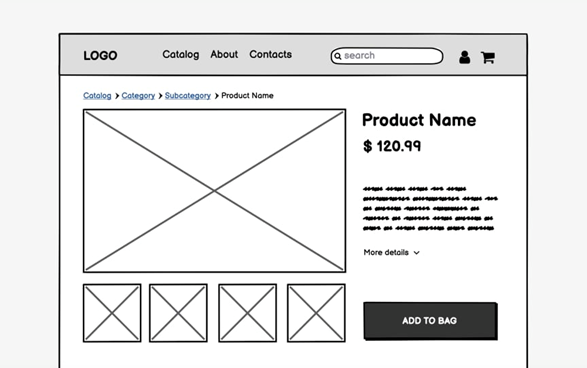
Wireframes are sketches of your website pages. They can be drawn with pencil and paper or digital drawing software. Website designers use these when pitching their ideas to clients and to help them visualise how they will build each page.
Drawing wireframes is quite quick and can save time by avoiding mistakes you might make if you jump in and start without a plan. It's also a great way to think about the layout without worrying about the content details such as photos, videos, colours, branding, and copy.
How to use wireframes:
- Use boxes to represent images
- Use lines to represent text
- Use shapes and boxes to represent buttons
- Draw the basic outline of the main menu, text boxes, headers, footers, and search bar.
Site map
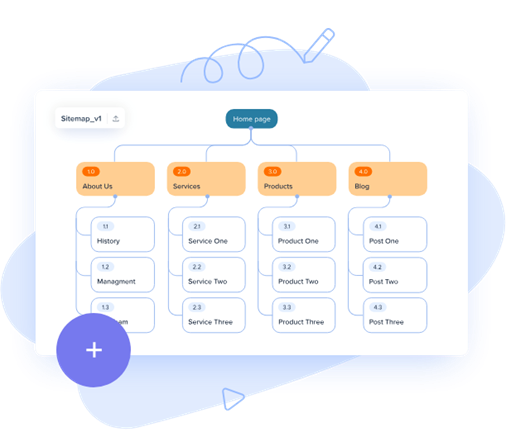
According to Google Search Central, a site map is an important map of your website. It is useful for users to navigate your website, especially if it has hundreds of pages. There are three types of sitemap:
- One for developers
- One for search engines
- One for human users
It visually displays how to get to each webpage from the main menu, header and footer links. A sitemap can also be used for planning the layout of a website. Draw a site map with digital drawing software, a spreadsheet, or a writing document.
Additional benefits of a sitemap:
- Generating a HTML or XML sitemap allows search engines to crawl your web pages easily and index your website (good for SEO)
- They are great for new websites that have few external links directing to it. Again, this helps search engines to rank your website.
- It is especially advantageous for websites that have over 500 pages.
Course 9
Customer service
The importance of excellent customer service
Providing excellent customer service is a crucial part of making sure your ecommerce business survives. Not only is it expected by online customers, but your successful competitors are offering this as well. Bad customer service leads to bad word-of-mouth and reviews, and a loss of repeat business.
Statistics
The Shep Hyken survey in 2023 shows that 76% of customers would go to another competitor if they experienced bad customer service. The study also found that 82% of customers have more trust in a company that provides excellent support.
Ecommerce customer service channels
Ideally, you should provide your customers with support on as many channels as possible. These include:
- Live chat (human preferred)
- Phone
- Website form
- Social media
How can I handle customer complaints?
Tips for handling customer complaints:
- Respond promptly to all customer messages including complaints. Aim to reply within one business day to prevent the customer from having a worse experience with your brand.
- Always use a courteous and polite tone.
- Apologise for customer dissatisfaction and offer ways to rectify the problem such as a refund or sending another item.
- Investigate customer problems diligently to show that you care about your customers and the service they receive.
- When customers complain openly, for example, on social media, leave a public reply that you will handle the issue by a private message.
- Have dedicated support channels for customer service, such as an email address, social media account, and/or telephone number.
Further reading: Best practices for ecommerce customer service
Templates for replying to customer complaints
There are some common complaints that you might receive at some point as a dropshipping business. You can write template responses to help you reply consistently and save time writing the same message to multiple customers. Here are some examples:
I've been waiting for my order for weeks and it still hasn't arrived?
- Ask for an order number if they didn't send one and if it's needed to find their order details
- Apologise for the delay
- If the tracking details show the order never arrived, it's recommended to offer a refund
Hi [NAME], we're very sorry to hear that your order hasn't arrived. I've checked your order number 1234 and I can see that it wasn't successfully delivered. To rectify the situation, I have authorised a full refund. Please allow 2-3 working days for the credit to show in your account. Our apologies again for this discrepancy and we hope that you will let us prove to you our true level of service in the near future.
I contacted you a while ago about my order and I haven't had a reply?
- Check to see the previous messages
- Apologise if no response was given
- Customise your reply depending on the situation
- If possible, give clear dates of when they can expect a solution
Hi [NAME], I'm sorry to hear that you are still waiting for a response from our customer service team. This isn't our normal level of service. We can confirm that this issue has now been transferred to one of our specialists who is looking into the matter. Please expect a reply with further information by Friday. Thank you for your patience.
I'm unhappy with the quality of my order. Can I get a refund?
- This depends on the law in the country you are selling. Typically, customers have a legal right to a refund if they are unsatisfied with an unused product within 14-30 days.
- If the worldmall product hasn't been used, you can offer a refund once they send it back within the agreed time period.
- If the product is claimed as faulty, ask for photos as evidence.
- If a worldmall product was damaged during transit or breaks within a short period of time, ask the customer to send the product back for a refund.
- Check the laws in your area and the return policy published on your dropshipping store.
Hi [NAME], we're sorry that you aren't satisfied with your order. Please send your unused item back to us within 14 days for a full refund. The address is listed below. Kindly note that customers will need to cover the cost of the return shipping. Thank you.
Part of my order is missing
- If it's possible, check if the whole order was sent to the customer.
- Send any missing products or missing pieces such as screws, nails, or accessories to assemble furniture, or issue a part refund.
- If the customer still doesn't receive the missing parts or items, you can offer a full refund.
Hello [NAME], we would like to apologise that your order has been sent incomplete. This is not our usual level of service and would like to correct this for you. Please confirm whether you would like us to send the missing items again without any charge, or if you would prefer a refund on these missing items. Thank you for your patience.
A product I want to purchase is always out of stock?
- Give clear dates for when there is a restock if possible
- Ask the customer to keep checking the website
Hi [NAME], thank you for your message. We're sorry that you have been unable to purchase the [PRODUCT NAME]. This is an extremely popular item and it typically sells out within the first day of restock. Please keep checking our website to see the product availability. We are expecting another restock in the next week.
There is always a long wait on the phone and I can't get connected to a customer service specialist?
- Apologise for the long delay to connect to the customer service team
- If possible, arrange a call back
- Ask if you can attend to their needs by email
Hello [NAME], we are sorry that you are dissatisfied with our customer service call team. Unfortunately, we have been experiencing very high levels of incoming calls. Please send us your phone number and preferred time of day for us to call. One of our representatives will call you back.
Why isn't there a phone number to call for customer service?
- Explain that this is due to saved costs for the customer
- Ask if you can help by email
Hi [NAME], thank you for your message. In order to keep the cost savings low for our customers, we are unable to offer customer care by phone at this time. We are happy to assist you as much as we can by email. Please send your request and we will reply promptly. Thank you for your understanding.
I'm unhappy with the customer service I have received
- Apologise for the customer's dissatisfaction
- Look into the situation to see what happened
- In extreme cases where the customer has been treated very poorly by a customer service specialist, offer a discount or complimentary gift card.
- If the customer has been difficult and the customer care team have tried to assist, then apologise and leave the issue.
Hello [NAME], we are very sorry to hear that you were not treated with the proper care that we strive to provide to all our customers. To compensate for this, we would like to offer you a complimentary gift card to the value of $25 to spend on [WEBSITE NAME]. We truly value each of our customers and hope that you will let us prove to you our usual attentive customer care in the near future.
I have suggestions for the website and your products
- Thank customers for sending suggestions
- This information is valuable for improving your services
- Consider creating a feedback prompt on the website or email survey
Hello [NAME], thank you for sending your feedback. We greatly appreciate suggestions from our customers as this helps us to improve our services. Your comments have been passed on to the relevant team for review.
Top tip:
When relevant, personalise each message before you send it. You can address the specific concerns of the customer or ask any questions to assist you in rectifying the situation.
Course 10
Price comparison websites
Description: Expand your customer reach by using price comparison websites for dropshipping. Find out how price comparison websites work, the benefits of using them, which ones are popular, and an easy walkthrough of how to register as a seller.
What is a price comparison website?
A price comparison website compares the prices of the products from different online sellers. They are popular with consumers for getting the best price for a particular item without spending hours researching each seller's website manually. Price comparison websites are also used to search for voucher and discount codes.
Why do consumers like price comparison websites?
The benefits for dropshipping on price comparison websites are similar to online marketplaces. These are:
- Convenience: It takes less time to find the best supplier of a product
- Price: It's easy for price-sensitive shoppers to get a great deal
- Trust: Consumers trust well-known price comparison websites
Why sell via price comparison websites?
| Advantages | Disadvantages |
|---|---|
|
|
Popular price comparison websites
These are some of the most trusted and most visited price comparison websites in different countries around the world.
USA
- Google Shopping
- Bizrate
- Bestproducts.com
- Yahoo Shopping
- Price.com
- Shopzilla
- Pronto
- PayPal Honey
Canada
- Google Shopping
- Best Products
- Biz Rate
- Shopbot
- PriceBat
- PriceGrabber
- Shopzilla
- PayPal Honey
UK
- Google Shopping
- Price Runner
- Kelkoo
- Idealo
- Price Spy
- Price Checker
- Hot UK Deals
- PayPal Honey
Europe
- Google Shopping (multiple countries)
- Kelkoo (multiple countries)
- Idealo (multiple countries)
- MyDealz.de (Germany)
- Bizrate (multiple countries)
- Secprf.com (multiple countries)
- Lemeilleuravis.fr (France)
- Comparis.ch (Switzerland)
- Prisjakt.no (Norway)
- Heureka.cz (Czech Republic)
- Trovaprezzi.it (Italy)
- Price Runner (multiple countries)
- Skapiec.pl (Poland)
- Moyo.ua (Ukraine)
- Beslist.nl (Netherlands)
- Cool Blue (multiple countries)
- Custojusto.pt (Portugal)
- Kuantokusta.pt (Portugal)
UAE
- Google Shopping
- Tellmyprice.com
- Secprf.com
- Yaoota
- Pricena
- Kanbkam
Australia
- Google Shopping
- Best Products
- Get Price
- Price Me
- Mozo
- My Deal
Japan
- Kakaku
- Yahoo Shopping
- Shoply
- Aucfan
- Findki
- Starday

